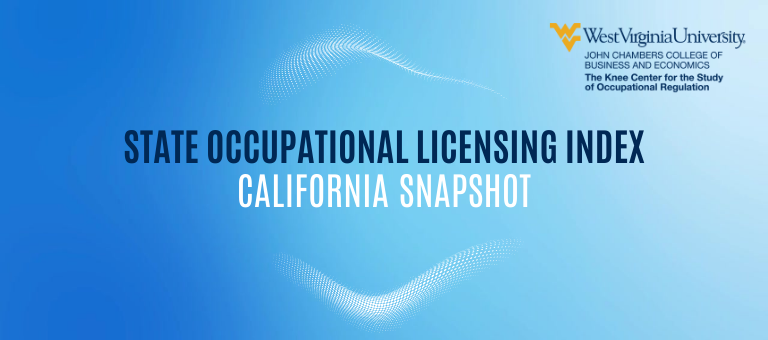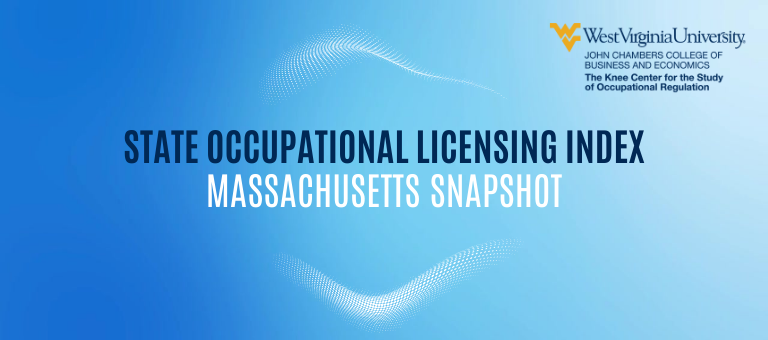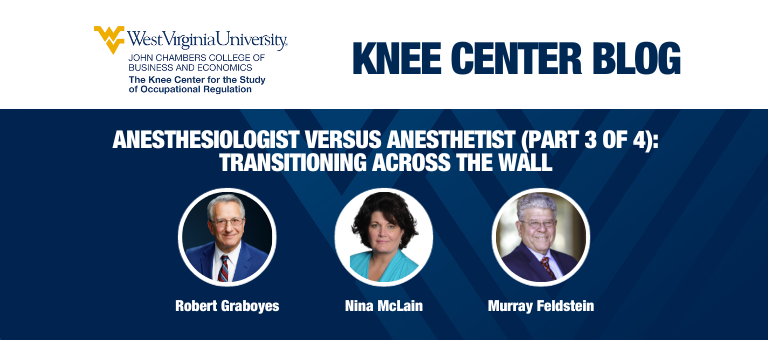
A Snapshot of Occupational Licensing in California
September 19, 2023
A Snapshot of Occupational Licensing in Massachusetts
September 21, 2023Anesthesiologist versus Anesthetist (Part 3 of 4):
Transitioning Across the Wall
Robert Graboyes, Nina McLain, and Murray Feldstein
A tall, unbreachable wall separates physicians and everyone else—nurses, psychologists, physical therapists, etc. A medical doctor/anesthesiologist (MD) performs similar (sometimes identical) work to that done by a certified registered nurse anesthetist (CRNA). Yet their training, credentials, licensure, privileges, and autonomy can differ sharply. Some states require CRNAs to work under the supervision of a physician, who may or may not have expertise in anesthesia. In any state, a nurse anesthetist who wishes to become an anesthesiologist will essentially have to go back to square one to make that transition—with little credit given to prior training and experience. This physician/nonphysician distinction is deeply engrained in American healthcare. But does the demarcation serve the interests of patients? Or is it merely an artifact of physicians’ 20th century political power? (Economist Milton Friedman said long ago that the American Medical Association was “the strongest trade union in the United States.”) Here, health economist Bob Graboyes discusses this demarcation with Nina McLain (a CRNA and professor in Mississippi) and Murray Feldstein (a retired urologist who “supervised” CRNAs in Arizona). This is the third of the following four segments:
- How do MD anesthesiologists differ from CRNAs in terms of training, knowledge, and professional roles?
- How do collaborative practice agreements (CPAs) work, and what do we mean by “full practice authority” for nurse anesthetists?
- What would be the present-day logistical hurdles for a nurse anesthetist who wished to transition to the role of physician (medical doctor or doctor of osteopathy)?
- What institutional arrangements could expedite such transitions, without compromising the quality of care?
While the focus here is on anesthesiology, our discussion is applicable to the physician/nonphysician divide. For simplicity, we will refer here to physicians as “MDs,” while noting that doctors of osteopathy (DOs) serve equally in this role. Before beginning, I’ll note that Nina was my doctoral student at Virginia Commonwealth University and Murray and co-authored a provocative series of articles arguing that healthcare professions might do well to emulate the manner in which the Federal Aviation Administration certifies pilots. – Bob Graboyes
What would be the present-day logistical hurdles for a nurse anesthetist who wished to transition to the role of physician (medical doctor or doctor of osteopathy)?
BOB: In a conversation with Murray, I posed a hypothetical. Suppose a nurse anesthetist like Nina decided for some reason, “I’d rather be an MD anesthesiologist.” Let’s explore that idea. First of all, why might a CRNA decide to become an MD? What could be the attraction?
MURRAY: Money. Prestige. Status. Some large hospitals will not let anesthetists work unless under direction or employment by anesthesiologists. Academic programs are set up that way most of the time. Again, it will vary by state, since some still do not grant CRNA’s the right to independent practice.
NINA: Hmm … maybe they want more school debt? (Kidding!) I think if they were interested in specializing in a specific type of practice, say pain management, and wanted to do it without restrictions, that would be an incentive. Currently, a CRNA who wants to do this has to be sure they live in a state where the laws allow it. Or, a younger person who had time and wanted to practice independently in a state that doesn’t allow independent practice by a CRNA might have an interest in going back to school. Those are really the only couple of reasons that would be worth it to me personally, but I am sure someone younger would have a different answer! I could survey for you and find out though.
CRNA salaries are really good. Many physician anesthesiologists in our area are encouraging their children to get nursing degrees and come to our program. Jokingly, I had one anesthesiologist ask me if he could get admitted to our program so he could have better hours. He claimed we make more per hour than he did after his overhead with his group, his low reimbursement from insurers, and a few other factors.
BOB: If an NA decided to become an anesthesiologist for one of these reasons, how much time and expense and effort would be involved in making the transition?
NINA: Well, there would be several courses that could transfer but there would still be many courses to take to even apply to the school. That could take two years depending on what prerequisite courses you had taken in college. I wanted to be a marine biologist and work with dolphins when I started college, so someone like me would have a few more science courses than others might. Then they would have take the Medical College Admissions Test (MCAT) and score really well, find a program willing to admit a CRNA, and go through the same rigorous admission process as everyone else.
Expense? Definitely a big consideration. In our state, to quit life as an experienced CRNA making $185,000 to $250,000 per year (plus more, depending on whether you take call or work extra days), and give that up to go full time to medical school? Eek! That is big. And then to be poor for another several years with low income as a resident at some point. I think realistically, that would be a major factor that would make the transition very unattractive to get the MD title and do essentially the same job we are doing now. As I suspect my esteemed economics professor would agree, that would be a poor decision.
BOB: So, if I’m not mistaken, it would take Nina the same time, expense, and effort to become an MD that it would take a 21-year-old just finishing an undergraduate education, right?
NINA: Well, again, that would depend on what other courses were taken during their undergraduate program. I’m unaware of any medical school that would give any type of credit for case hours or experience, but to be honest, I have never investigated that. Essentially, that sounds right.
BOB: But, unlike the graduating college senior, a CRNA like Nina already possesses a large percentage of the knowledge base required for an MD. In a perfect, frictionless world, how much time would a nurse anesthetist really need to acquire the missing pieces of a medical degree–to become an anesthesiologist?
MURRAY: It really depends upon the nurse’s prior experience. How long did the nurse work before deciding to change titles? Where was he or she employed: Big hospital? Academic center? Smaller community hospital? Was the nurse working independently or as an employee of a large MD anesthesiology practice under rigid supervision? What kind of procedures did the nurse do before? Open heart surgery or outpatient hernias in healthy patients?
The more experienced nurse might already be more knowledgeable and skillful than an anesthesiologist freshly minted out of a residency. In that case, the only thing the nurse would need to do would be to get acclimated to the standard operating procedures of the particular institution in which he or she was working. But if the nurse was relatively inexperienced, and only a year or two out of her anesthesia program, and had only been involved in managing healthy patients in minor elective procedures, he or she might need to take a refresher courses in respiratory physiology, pharmacology, and a year or more of a supervised residency. Especially if he or she were now going to something complex, like heart transplant work. What do you think Nina?
NINA: Murray is spot-on as far as my understanding. Our graduates straight out of school have all the required case types and procedures. They do cardiac and vascular surgery cases—all the big ones the docs do. In a perfect world without egos and silly interprofessional frictions, some type of system could be developed to give credit via testing or simulations if anyone was interested in making a transition. As the professional climate is now, that could only happen in a few places. Someone like me would have to take 12-14 courses and some labs to be able to apply. I guess the one advantage over the other students would be their base knowledge in anesthesia and their experience, abilities, crisis management, and critical thinking/diagnostic abilities. Heck, they may even be top of the class, as they would be starting with some really awesome pearls in their pocket.
So, the crazy thing is—CRNAs do transplants, in school and afterward if they choose to work in those kinds of facilities. In our area, those facilities are usually larger private organizations or university medical centers, where physician anesthesiologists are generally either the supervisors or medical directors. In our state, legally, the CRNA can collaborate with a surgeon and be the anesthesia provider for a transplant team. But realistically, since transplants are done here at the larger private hospitals or university medical center, the docs are in charge. Again, the prohibitive factor is the model, not the ability. If a CRNA had not done a transplant since training and wanted to accept a position like that, a sane one would certainly want some specialized mentoring by an experienced anesthesia provider, whether CRNA or physician. “No cowboy anesthesia” is what we preach at our program.
And Murray is right about having to be a doc to get a good fellowship. Once, I was curious if I could apply for a post-graduate fellowship in anesthesia. I was really into grant-writing at the time. I still love it. At that time, all federal funding for fellowships was for physicians. A lot of funding was available for nursing, focused on qualitative research and traineeships for things that had nothing to do with anesthesia. There are now CRNA fellowships coming about through schools. I know of some in pain management and pediatrics, for example. But the federal funding has not materialized for CRNAs as it has for the docs. But then, that starts my brain on the train track of graduate medical education (GME) funding for physicians only. And I try hard to keep that tamed and save that to tackle closer to retirement. With the huge nursing shortage (a.k.a., “crisis”), I am fighting the urge to scream about no equal GNE (Graduate Nursing Education) funding with the same model as the GME. But again, that would take an act of Congress, literally, as you described at the first of this series, and the AMA has the power and money.
BOB: And therein lies a fundamental problem with the very idea of licensure, as opposed to, say, certification. It encourages the establishment of rigid, inflexible, one-size-fits-all arrangements. To filter out unqualified or incompetent providers, they employ heuristics that inadvertently filter out people who are qualified and competent, but who acquired those skills in unconventional ways. At other times, licensure boards’ focus wanders away from the public interest to their own interest, and the power to bestow or to deny a license gives rise to self-interested fiefdoms—guilds, if you prefer. In the fourth and final segment of our conversation, we’ll talk about how alternative pathways to licensure might serve the public interest.
Blog Series:
Bob Graboyes is a health economist and Senior Research Affiliate with the Knee Center for the Study of Occupational Regulation. He holds a PhD in economics at Columbia University. He was previously a specialist on Sub-Saharan Africa with Chase Manhattan Bank, and his travels on that continent instilled him with an acute sense of the importance of healthcare and the wildly varying ways that care is delivered.
——————
Nina McLain is the Nurse Anesthesia Program Administrator and tenured Associate Professor at The University of Southern Mississippi, with a clinical practice in central Mississippi. She has provided anesthesia in several anesthesia models including collaborative agreements with surgeons/physicians as the solo CRNA and in a medical team model of both direction and supervision with MD anesthesiologists. She has been a CRNA for 30 years and a registered nurse for 5 years before that. She served as Vice President of the Mississippi Association of Nurse Anesthetists and is currently on the National Advisory Council for Nurse Education and Practice, which advises the U.S. Secretary of the Health and Human Services. She holds a Ph.D. in Health Related Science from Virginia Commonwealth University.
——————
Murray Feldstein is a retired urologist. He received his M.D. from the University of Pennsylvania School of Medicine in 1967, did a general (rotating) internship for a year at the University of Oregon, and then served as a general medical officer in the U.S. Army’s 82nd Airborne Division. He took his initial surgical training at the University of New Mexico and then finished his urology training at the University of Arizona—the first resident who graduated from that program. He practiced in Flagstaff, Arizona for 25 years, and also worked at the Tuba City Hospital on the Navajo and Hopi reservations. His partner and he started outreach clinics throughout Coconino, Yavapai, and Navajo counties. Murray briefly retired in 2000, but then was asked to join the Mayo Clinic in Phoenix and became an Assistant Professor until his retirement eight years ago.


